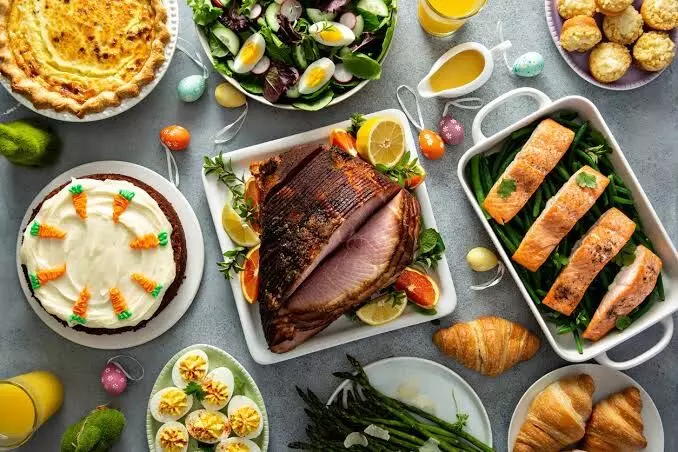Happy Easter: Of glazed hams, buttered rolls, chocolate bunnies
The Easter feast is a psychological, cultural, and historical tapestry woven from centuries of tradition, deprivation, reward, and even survival instinct
By Anoushka Caroline Williams
Happy Easter: Of glazed hams, buttered rolls, chocolate bunnies
Hyderabad: Every Easter, tables groan under the weight of glazed hams, buttered rolls, chocolate bunnies, colored eggs, and desserts stacked like edible skyscrapers. And while much of the day is framed by religious reflection or springtime celebration, there’s no denying that feasting has become a central—and nearly sacred—part of the modern Easter ritual.
But why do we eat so much on Easter?
The answer lies far deeper than simple indulgence. The Easter feast is a psychological, cultural, and historical tapestry woven from centuries of tradition, deprivation, reward, and even survival instinct.
From Famine to Feast: The Historical Blueprint
Easter doesn’t exist in a vacuum. It follows Lent, a 40-day season of restraint and sacrifice for Christians around the world. Traditionally, this period involved abstaining from meat, dairy, and rich foods—a sort of spiritual detox.
“Feasting after fasting is hardwired into the human ritual cycle,” says Dr. Nikita Puramsetty, a cultural psychologist, speaking to Newsmeter. “When you deprive yourself for a significant period, especially in a religious or spiritual context, the return to abundance becomes not just a physical relief, but a psychological high.”
The Easter meal is therefore not just a meal—it’s a reward. A celebration. A signal to the brain that the hardship is over, and joy has returned.
The Psychology of Permission: “Holiday Eating” Is Different
There’s something about holidays that grants us an internal permission slip to eat more than we usually would. And Easter, with its pastel cheer and family-centered traditions, is no exception.
“We categorize food differently on holidays,” explains Ravi Kiran, a behavioral nutritionist. “What might feel like overeating on a regular day is reframed as a celebration on Easter. Our brain isn’t just consuming calories; it’s consuming emotion, memory, and meaning.”
Indeed, Easter food is often drenched in nostalgia—grandma’s lamb roast, mom’s potato salad, the chocolate egg hunt from childhood. We’re not just eating to eat; we’re participating in a ritual that connects us to our past, to our families, to our sense of identity.
Sugar, Dopamine, and Childhood Echoes
Then, of course, there’s the candy.
Easter is second only to Halloween in terms of candy sales in many Western countries. From marshmallow chicks to giant chocolate bunnies, it’s a sugar-saturated celebration.
Why do we lean so hard into sweets? Psychology gives us a few clues.
“Sweets activate the reward system in our brain, especially dopamine pathways,” says Dr. Puramsetty. “On holidays like Easter, the emotional context amplifies that effect. You’re not just getting a sugar high—you’re getting a memory high.”
Many of us associate Easter candy with childhood freedom, springtime joy, and the excitement of the egg hunt. Our adult brains chase those feelings, even if we’re long past the age of racing through the yard with a plastic basket.
Food as Love, Community, and Comfort
Easter, like many holidays, is fundamentally about togetherness, and food plays a starring role in that connection. Sharing meals has always been one of the oldest forms of bonding across human cultures.
“Food is a language of love,” says Fr. Aloysius. “At Easter, we’re not just feeding our bodies. We’re feeding our spirits. In the wake of loss, of winter, of sacrifice—this feast says: We made it. We’re here. Together.”
In times of global uncertainty, people often lean even harder into holiday rituals. The Easter table becomes a sanctuary—where family arguments fade behind full plates, and the stress of the outside world is temporarily softened by whipped cream and laughter.
But Is It Too Much? A Gentle Reminder
While Easter feasting has deep roots and beautiful reasons behind it, it’s also easy to tip into guilt or discomfort afterward, especially in a culture steeped in diet shame.
Experts agree: one day of indulgence does not define your health. What matters more is why we eat—and how we relate to our food.
“If you’re eating out of joy, connection, and gratitude, that’s vastly different than binging in a disconnected or compulsive way,” says Dr.Puramsetty. “Mindful enjoyment is part of a healthy relationship with food. Easter can be both celebratory and balanced.”
Conclusion: The Feast is the Message
Easter is about rebirth, renewal, and the return of joy after darkness. Our plates reflect that. We feast because we’re alive. Because we remember. Because we need to mark the turning of seasons in a way that our bodies understand.
So go ahead—have the extra slice of pie. Raise a toast. Pass the potatoes. The feast isn’t just tradition; it’s transformation. And in the act of gathering, sharing, and savoring, we’re honoring something ancient and deeply human.
That’s the psychology behind the second (or third) helping. And maybe—just maybe—it’s sacred too.